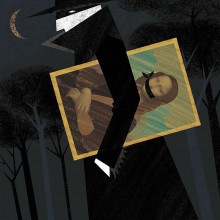The Mona Lisa is perhaps one of the best-known pictures in human history. After the death of Leonardo da Vinci, it was acquired by French King Francis I, and it “settled” at the Louvre in 1793. In the 20th century, the picture left the museum’s premises three times only – in 1911, 1963, and 1974. In the two latter cases, it was taken to the US and Japan, respectively. The most interesting case was in 1911: on August 21 Vincenzo Peruggia, an Italian mirror master employed at the Louvre, stole the Mona Lisa.
Once it was found on the next day that the masterpiece had disappeared, the museum was closed and search began. The thief was promised, through the press, anonymity and a reward. For it was very likely that, unable to sell the picture, the thief will just destroy it. But he kept silent.
Only two years later, an Italian gallery employee reported to the police that somebody offered to sell him the picture. This helped the picture to return to the Louvre, while Peruggia was arrested. Interestingly, the thief’s motive for the theft was a desire to bring the national treasure back to Italy. It is not known whether this became a mitigating circumstance, but Peruggia was sentences to only a year in prison.







